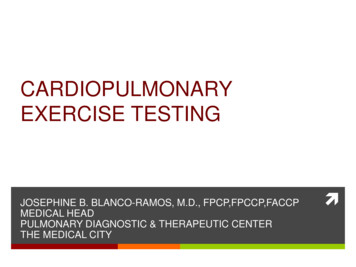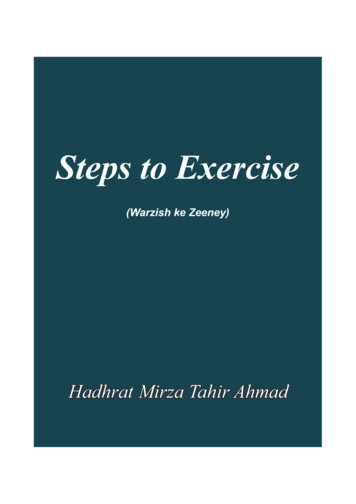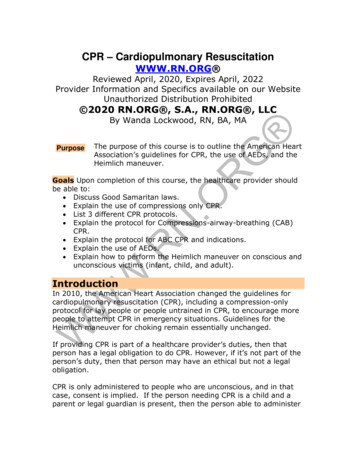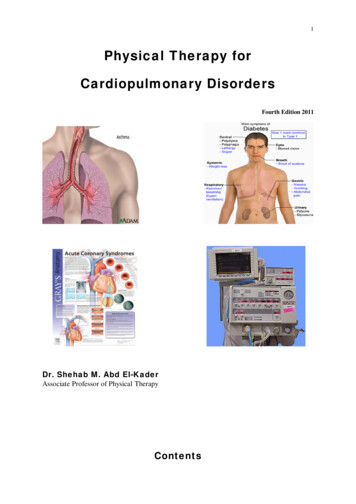
Transcription
CARDIOPULMONARYEXERCISE TESTINGJOSEPHINE B. BLANCO-RAMOS, M.D., FPCP,FPCCP,FACCPMEDICAL HEADPULMONARY DIAGNOSTIC & THERAPEUTIC CENTERTHE MEDICAL CITY
OUTLINE Description of CPET Who should and who should not get CPET When to terminate CPET Exercise physiology Define terms: respiratory exchange ratio, ventilatoryequivalent, heart rate reserve, breathing reserve, oxygenpulse Patterns of CPET results
Karlman Wasserman, MD
SOURCES OF ENERGY FOR ATP
Derangements of gas exchange in disease.Milani R V et al. Circulation. 2004;110:e27-e31Copyright American Heart Association, Inc. All rights reserved.
Coupling of External Ventilationand Cellular Metabolism
WHY EXERCISE ? The goal of CARDIO-PULMONARY exercisetesting is to evaluate the physiologic responseof the heartlungs andmuscles to an increase in physical stress.
CASE 50 year old, male, computertechnician retired 10 years ago becauseof progressive dyspnea was a heavy cigarettesmoker, but deniescough/phlegm/wheezing/chest pains recurrent pneumothoraxsecondary to multiple bullousdisease
FVCFEV1Predicted4.843.73Measured1.881.48%Pred3940
QUESTION 1: WOULD YOU CLEAR THIS PATIENT FORPNEUMONECTOMY? A. YES B. NO
Predicted Post -Operative FEV1PPO FEV1 Pre-Op FEV1 x (1-a/b)a number of unobstructed segments to be removedb total number of unobstructed segmentsPPO FEV1 1480 ml ( 1 - 9/19) 778 ml
QUESTION 2: WHAT IS THE NEXT MOST APPROPRIATEDIAGNOSTIC PROCEDURE TO CONFIRMWHETHER THIS PATIENY CAN UNDERGOPNEUMONECTOMY? A. STAIR CLIMBING B. DIFFUSION CAPACITY C. VENTILATION-PERFUSION SCANNING D. CARDIOPULMONARY EXERCISE TESTING
Use of CPX in the clinical evaluation of chronic dyspnea.Balady G J et al. Circulation. 2010;122:191-225Copyright American Heart Association, Inc. All rights reserved.
INDICATIONS FOR CPET Evaluation of dyspnea distinguish cardiac vs pulmonary vs peripherallimitation vs others detection of exercise-induced bronchoconstriction detection of exertional desaturation Pulmonary rehabilitation exercise intensity/prescription response to participation Pre-op evaluation and risk stratification Prognostication of life expectancy
INDICATIONS Disability determination Fitness evaluation Confirm the diagnosis Assess response to therapy
ABSOLUTE CONTRAINDICATIONS TOCPET Acute MI Unstable angina Unstable arrhythmia Acute endocarditis, myocarditis, pericarditis Syncope Severe, symptomatic Atrial Stenosis Uncontrolled CHF
ABSOLUTE CONTRA Acute PE, DVT Respiratory failure Uncontrolled asthma SpO2 88% on RA Acute significant non-cardiopulmonary disorder thatmay affect or be adversely affected by exercise Significant psychiatric/cognitive impairment limitingcooperation
RELATIVE CONTRAINDICATIONS Left main or 3-V CAD Severe arterial HTN ( 200/120) Significant pulmonary HTN Tachyarrhythmia, bradyarrhythmia High degree AV block
RELATIVE CONTRA Hypertrophic cardiomyopathy Electrolyte abnormality Moderate stenotic valvular heart disease Advanced or complicated pregnancy Orthopedic impairment
INITIAL EVALUATION HISTORY: tobacco use, medications, tolerance to normalphysical activities, any distress symptoms, contraindicatedillnesses PHYSICAL EXAM: height, weight, assessment of heart,lungs, peripheral pulses, blood pressure EKG PULMONARY FUNCTION TESTS: spirometry, lungvolumes, diffusing capacity, arterial blood gases
PRIOR TO THE TEST Wear loose fitting clothes, low-heeled or athletic shoes Abstain from coffee and cigarettes at least 2 hours beforethe test Continue maintenance medications May eat a light meal at least 2 hours before the test
CARDIOPULMONARY EXERCISE TEST (CPET) symptom-limited exercisetest measures airflow, SpO2,and expired oxygen andcarbon dioxide allows calculation of peakoxygen consumption,anaerobic threshold
EXERCISE MODALITIES Advantages of cycle ergometer cheaper safer Less danger of fall/injury Can stop anytime direct power calculation Independent of weight Holding bars has no effect little training needed easier BP recording, blooddraw requires less space less noise Advantages of treadmill attain higher VO2 more functional
COMPARISON OF CYCLE VS TREADMILLCYCLETREADMILLVO2 MAXLOWERHIGHRLEG MUSCLE FATIGUEOFTEN LIMITINGLESS LIMITINGWORK RATE QUANTIFICATIONYESESTIMATIONWEIGHT BEARING IN OBESELESSMORENOISE & ARTIFACTSLESSMORESAFETY ISSUESLESSMORE
EXERCISE TEST PROTOCOLSINCREMENTALRAMPWORKWORKTIMETIME
INDICATIONS TO EXERCISE TERMINATION Patient’s request: fatigue, dyspnea, pain Ischemic ECG changes 2 mm ST depression Chest pain suggestive of ischemia Significant ectopy 2nd or 3rd degree heart block Bpsys 240-250, Bpdias 110-120
INDICATIONS TO TERMINATION Fall in BPsys 20 mmHg SpO2 81-85% Dizziness, faintness Onset of confusion Onset of pallor
General Mechanisms of Exercise Limitation Pulmonary Ventilatory impairment Respiratory muscledysfunction Impaired gas exchange Cardiovascular Reduced stroke volume Abnormal HR response Circulatory abnormality Blood abnormality Peripheral Inactivity Atrophy Neuromusculardysfunction Reduced oxidativecapacity of skeletalmuscle Malnutrition Perceptual Motivational Environmental
CPET Measurements Work RR VO2 SpO2 VCO2 ABG AT Lactate HR Dyspnea ECG Leg fatigue BP
Metabolic endpoint to evaluate results of therapeutic interventions.Milani R V et al. Circulation. 2004;110:e27-e31Copyright American Heart Association, Inc. All rights reserved.
PULMONARY PARAMETERS 1. MINUTE VENTILATION NORMAL 5 – 6 liters/ minAT EXERCISE 100 liters/minincrease is due to stimulation of the respiratory centersby brain motor cortex, joint propioceptors andchemoreceptorsANAEROBIC THRESHOLD (AT) the minute ventilationincreases more than the workload
PULMONARY 2. TIDAL VOLUME NORMAL 500 ml DURING EXERCISE 2.3 – 3 liters increases early in the exercise increases ventilation
PULMONARY 3. BREATHING RATE NORMAL 12 – 16 / minAT EXERCISE 40 – 50 / minresponsible for the increase in minute ventilation
PULMONARY 4. DEAD SPACE / TIDAL VOLUME ratio0.20 – 0.40 AT EXERCISE 0.04 – 0.20 decrease is due to increased tidal volumewith constant dead space NORMAL
PULMONARY 5. PULMONARY CAPILLARY BLOOD TRANSIT TIME NORMAL 0.75 secondAT EXERCISE 0.38 secondthe decrease is due to increased cardiac output6. ALVEOLAR-ARTERIAL OXYGEN DIFFERENCE NORMAL 10 mm HgAT EXERCISE 20 – 30 mm Hgchanges very little until a heavy workload is achieved
PULMONARY 7. OXYGEN TRANSPORT increase in temperature, PCO2 and relative acidosis inthe muscles - increase in release of Oxygen by bloodfor use by the tissues for metabolism
CARDIOVASCULAR PARAMETERS 1. CARDIAC OUTPUT NORMAL 4 – 6 liters / minAT EXERCISE 20 liters / minincrease is linear with increase in workload duringexercise until the point of exhaustionfirst half of exercise capacity, the increase is due toincrease in Heart Rate and Stroke Volumelater, due to increase in Heart Rate alone
CARDIOVASCULAR 2. STROKE VOLUME NORMAL 50 – 80 mlAT EXERCISE doubleincrease is linear with increase in workloadafter a Heart Rate of 120/ min, there is little increasein Stroke Volume
CARDIOVASCULAR 3. HEART RATE NORMAL 60 – 100 /min AT EXERCISE 2.5 – 4 times the resting HR HR max is achieved just prior to totalexhaustion, physiologic endpoint of anindividual HR max HR max 220 – age210 – (0.65 x age)
CARDIOVASCULAR 4. OXYGEN PULSE NORMAL 2.5 – 4 ml O2 / heartbeatAT EXERCISE 10 – 15 mlWith increasing muscle work during exercise, eachheart contraction must deliver a greater quantity ofoxygen out to the body O2 PULSE VO2/ HR
CARDIOVASCULAR 5. BLOOD PRESSURE DURING EXERCISE: Systolic BP increases (to 200 mm Hg) Diastolic BP is relatively stable (up to 90 mmHg) increase in Pulse Pressure (difference between Systolic andDiastolic pressures)
CARDIOVASCULAR 5. ARTERIAL – VENOUS OXYGEN CONTENTDIFFERENCE mL of O2 / 100 ml of blood NORMAL 5 vol %AT EXERCISE 2.5 – 3 times higherthe increase is due to the greater amounts of Oxygenthat are extracted by the working muscle tissue
METABOLIC PARAMETERS 1. OXYGEN CONSUMPTION NORMAL 250 ml / min3.5 – 4 ml / min / kg increases directly with the level of muscular work increases until exhaustion occurs and until individualreaches . VO2max maximum level of oxygen consumptiondefinite indicator of muscular work capacityNORMAL RANGE 1,700 – 5,800 ml / min
METABOLIC 2. CARBON DIOXIDE PRODUCTION NORMAL AT EXERCISE 200 ml / min2.8 ml / min / kginitial phase, increases at same rate as VO2 once Anaerobic Threshold (AT) is reached, increases at afaster rate than VO2 increase is due to increased acid production
Lactic Acid is Buffered by BicarbonateLactic acid HCO3 H2CO3 Lactate H2O CO2
METABOLIC 3. ANAEROBIC THERSHOLD (AT) NORMAL: occurs at about 60% of VO2 max followed by breathlessness, burning sensationbegins in working muscles
METABOLIC 4. RESPIRATORY QUOTIENT (RQ) RESTING LEVEL 0.8 AT 1.0 or more may exercise for a short time on 1.5 RER CO2 produced / O2 consumed VCO2 / VO2 5. BLOOD pH relatively unchanged until AT is reached the body becomes less able to buffer the excessiveacid produced by anaerobic metabolism
INCREASES DURING EXERCISE Heart rate Minute ventilation Oxygen extraction Alveolar ventilation Cardiac output Oxygen pulse Oxygen uptake RQ and RER Carbon dioxide output METS Arterial bloodpressure
DECREASES DURING EXERCISE During exercise, there are decreases in: VD/ VT
Ventilatory Equivalents Ventilatory equivalent for carbon dioxide Minute ventilation / VCO2 Efficiency of ventilation Liters of ventilation to eliminate 1 L of CO2 Ventilatory equivalent for oxygen Minute ventilation / VO2 Liters of ventilation per L of oxygen uptake
Relationship of AT to RER and Ventilatory Equiv for O2 Below the anaerobic threshold, with carbohydratemetabolism, RER 1 (CO2 production O2 consumption). Above the anaerobic threshold, lactic acid is generated. Lactic acid is buffered by bicarbonate to produce lactate,water, and carbon dioxide. Above the anaerobic threshold, RER 1 (CO2 production O2 consumption). Carbon dioxide regulates ventilation. Ventilation will disproportionately increase at lactatethreshold to eliminate excess CO2. Increase in ventilatory equivalent for oxygen demarcates theanaerobic threshold.
Lactate Threshold
Determination of AT from Ventilatory Equivalent Plot
Wasserman 9-Panel Plot
Interpretation of CPET Peak oxygen consumption Peak HR Peak work Peak ventilation Anaerobic threshold Heart rate reserve Breathing reserve
Estimation of Predicted Peak HR 220 – age For age 40: 220 - 40 180For age 70: 220 - 70 150210 – (age x 0.65) For age 40: 210 - (40 x 0.65) 184For age 70: 210 - (70 x 0.65) 164
Heart Rate Reserve Comparison of actual peak HR and predicted peak HR (1 – Actual/Predicted) x 100% Normal 15%
Flow chart for the differential diagnosis of exertional dyspnea and fatigue.Milani R V et al. Circulation. 2004;110:e27-e31Copyright American Heart Association, Inc. All rights reserved.
Abnormal patterns of responses from CPX characteristic of disorders that cause dyspneaBalady G J et al. Circulation. 2010;122:191-225Copyright American Heart Association, Inc. All rights reserved.
Estimation of Predicted Peak HR 220 – age For age 40: 220 - 40 180 For age 70: 220 - 70 150 210 – (age x 0.65) For age 40: 210 - (40 x 0.65) 184 For age 70: 210 - (70 x 0.65) 164
Breathing Reserve Comparison of actual peak ventilation and predictedpeak ventilation Predicted peak ventilation MVV, or FEV1 x 35 (1 – Actual/Predicted) x 100% Normal 30%
Comparison CPET resultsNormalCHFCOPDPredicted Peak HR150150150Peak HR150140120MVV10010050Peak VO22.01.21.2AT1.00.61.0Peak VE604049Breathing Reserve40%60%2%HR Reserve0%7%20%Borg Breathlessness548Borg Leg Discomfort885
CPET InterpretationPeak VO2 HRRBRAT/VO2maxA-aNormal 80% 15% 30% 40%normalHeart disease 80% 15% 30% 40%normalPulm vasc dis 80% 15% 30% 40%increasedPulm mech dis 80% 15% 30% 40%increasedDeconditioning 80% 15% 30% 40%normal
Cardiac vs Pulmonary Limitation Heart Disease Breathing reserve 30% Heart rate reserve 15% Pulmonary Disease Breathing reserve 30% Heart rate reserve 15%
QUESTION 3: WOULD YOU CLEAR THIS PATIENT FORPNEUMONECTOMY? A. YES B. NO
CPET to Predict Risk of Lung Resection in LungCancerLim et al; Thorax 65:iii1, 2010Alberts et al; Chest 132:1s, 2007Balady et al; Circulation 122:191, 2010 Peak VO2 15 ml/kg/min No significant increased risk of complications or death Peak VO2 15 ml/kg/min Increased risk of complications and death Peak VO2 10 ml/kg/min 40-50% mortality Consider non-surgical management
SUMMARY Cardiopulmonary measurements obtained at restmay not estimate functional capacity reliably. CPET includes the measurement of expired oxygenand carbon dioxide. CPET may assist in pre-op evaluation and riskstratification, prognostication of life expectancy, anddisability determination. Cycle ergometer permits direct power calculation. Peak VO2 is higher on treadmill than cycleergometer
SUMMARY Peak VO2 may be lower than VO2max. Absolute contraindications to CPET include unstablecardiac disease and SpO2 88% on RA. Fall in BPsys 20 mmHg is an indication to terminateCPET. 1 glucose yields 36 ATP in slow twitch fiber, and 2 ATP 2 lactic acid in fast twitch fiber. RER CO2 produced / O2 consumed
SUMMARY Above the anaerobic threshold, CO2 production exceeds O2consumption. Ventilation will disproportionately increase at lactatethreshold to eliminate excess CO2. AT may be determined graphically from V slope method orfrom ventilatory equivalent for CO2. Derived from the Fick equation, Oxygen Pulse VO2 / HR,and is proportional to stroke volume. In pure heart disease, BR is 30% and HRR 15%. In pure pulmonary disease, BR is 30% and HRR 15%.
REFERENCES Principles of Exercise Testing and Interpretation, 5th edition, Dr.Karl Wasserman Cardiopulmonary Exercise TestingHow Do We Differentiate the Causeof Dyspnea? Milani, RV, Lavie CJ, Mehra MR., Circulation.2004; 110:e27-e31 Clinician’s Guide to Cardiopulmonary Exercise Testing in Adults,A Scientific Statement From the American Heart Association,Circulation.2010; 122: 191-225
Normal CHF COPD Predicted Peak HR 150 150 150 Peak HR 150 140 120 MVV 100 100 50 Peak VO 2 2.0 1.2 1.2 AT 1.0 0.6 1.0 Peak VE 60 40 49 Breathing Reserve 40% 60% 2% HR Reserve 0% 7











